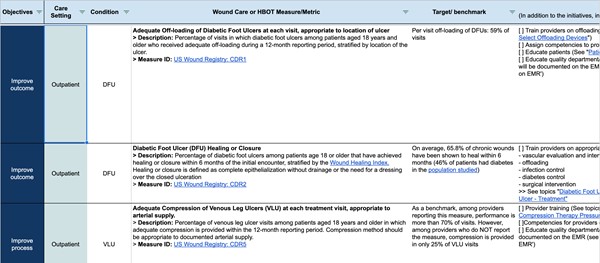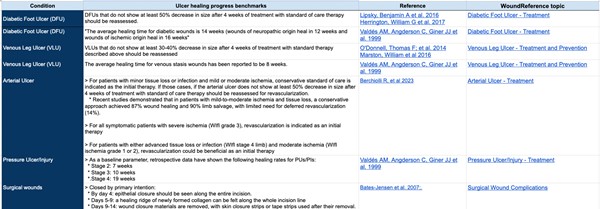Last updated on 10/28/24 | First published on 6/7/21 | Literature review current through Sep. 2025
[cite]
Authors:
Elaine Horibe Song MD, PhD, MBA,
Tiffany Hamm ,
Eugene Worth MD, M.Ed., FABA, ABPM/UHM,
Topic editors:
Cathy Milne APRN, MSN, CWOCN-AP,
Amy Smith JD, RN, PHN,
more...
Coauthor(s)
Elaine Horibe Song, MD, PhD, MBACo-Founder and Editor, Wound Reference, Inc;
Professor (Affiliate), Division of Plastic Surgery, Federal University of Sao Paulo;
Volunteer, Association for the Advancement of Wound Care;
Google Scholar Profile
Disclosures: Nothing to disclose
Eugene Worth, MD, M.Ed., FABA, ABPM/UHM
Disclosures: Nothing to disclose
Tiffany Hamm,
Disclosures: Nothing to disclose
Editors
Amy Smith, JD, RN, PHN
Disclosures: Nothing to disclose
Cathy Milne, APRN, MSN, CWOCN-AP
Disclosures: Nothing to disclose
For full access to this topic and more
premium content, upgrade today. Or get started with a Free Basic account (limited content and tools).
INTRODUCTION
Overview
Hospitals, health systems and their departments are often required to measure and track performance to ensure quality health care services.[1][2][3] However, guidance on strategic planning and performance improvement tailored to wound care and hyperbaric oxygen therapy (HBOT) programs is still scarce. Balanced scorecards (BSCs) have been used in healthcare as a tool to plan and implement quality improvement initiatives, and participate in quality programs introduced by payers (e.g.Centers for Medicare & Medicaid Services - CMS Quality Programs).[4][2][5] Based on the mindset "What you measure is what you get", the BSC allows managers to align their objectives with the organization's mission and vision, and to select, implement and monitor measures to achieve those objectives.[6][4]
This topic provides an Editable Balanced Scorecard Tool with sample metrics for wound care and HBOT programs. Institutions can make a copy of the tool, and use it to select and monitor their own objectives and metrics, according to their own vision and mission.
Background
Over the past years, there has been an increasing number of initiatives to improve the quality of care that people in the United States receive.[1][7] Hospitals and health systems are often required to measure and track performance to ensure quality health care services.[1][2][3] The Hospital Value-Based Purchasing Program, CMS Quality Payment Program, Home Health Value-Based Purchasing are examples of programs that encourage accountability and quality of care while aiming at reducing overall health care expenditure.[3]
Originally designed for businesses, the Balanced Scorecard was first introduced in 1992 by Kaplan and Norton, as a set of measures that gives managers a fast but comprehensive view of the business.[6] The BSC allows teams within an institution to align their goals with the institution's visions.[8]
A BSC contains 4 perspectives, each with its own objectives and measures. Collectively, the 4 perspectives help an organization avoid making improvements in one area that will negatively affect the organization in a different way.[8]
The 4 perspectives of a BSC are [6]:
- Financial,
- Customer,
- Internal business processes, and
- Learning and innovation
In healthcare, the BSC has many applications. For instance, it has been used in the following cases [8][4][9]:
- When evaluating whether current practices meet the customer or organizational needs.
- When determining how to measure and monitor improvement efforts, during either an initial trial or standardization.
- When creating goals for improvement and determining how those goals will be met.
- When determining areas for improvement.
In addition, the BSC may provide a structured framework for organizations participating in CMS Quality Programs. These programs encourage improvement of quality through payment incentives, payment reductions, and reporting information on healthcare quality on government websites. [3]
Despite its many advantages, it may be difficult to develop measures for each of the necessary 4 perspectives.[8] Furthermore, guidance on strategic planning and performance improvement tailored to wound care and hyperbaric oxygen therapy (HBOT) programs is scarce. This topic provides an Editable Balanced Scorecard Tool with sample objectives and measures aligned with CMS Quality Programs, and specific to wound care and HBOT programs.
WOUND MANAGEMENT AND HBOT BALANCED SCORECARD
Instructions
To develop a Balanced Scorecard, managers might opt to follow the steps listed by the Agency for Healthcare Research and Quality (AHRQ):
- 1. Come to a consensus on the organizational strategy and vision
- 2. Consider what each of the 4 perspectives means for the organization: customer, internal business, innovation and learning, and financial. Add any perspectives if you determine you need one. If the names of any perspectives need to be changed so they are more relevant or meaningful to your organization, change them.
- 3. For each perspective, choose at most five measures to indicate progress toward achieving the organization's strategy.
- 4. For each measure, choose ambitious targets. Targets should be selected so as to move the organization towards its vision when they are achieved.
Using the Editable Balanced Scorecard Tool:
- The tool provides a sample BSC for wound care and HBOT programs, which can be edited and customized by each organization. Managers can view and select quality measures that are specific for wound care and HBOT programs. Those quality measures and respective benchmarks have been compiled from CMS Quality Programs and organized according to relevant care settings.
- To view and example of how the tool is utilized, click on 'View Sample Data'
- To make a copy that you can edit with your own program's data, click on 'Make a Copy' (for WoundReference premium subscribers only. Please note that a Google account is required)
- Once an editable copy has been made:
- The tool has 3 tabs: "Balanced Scorecard Overview", "Wound Care and HBOT Measures/Metrics & Benchmarks" and "Ulcer Healing Benchmarks" (Figures 1 to 3)
- Managers who need a complete BSC might opt to utilize the template provided in the tab "Balanced Scorecard Overview", and populate it with metrics/measures selected from the tab "Wound Care and HBOT Measures/Metrics & Benchmarks".
- Managers whose departments already have a BSC might opt to update their existing BSC with metrics/measures and respective benchmarks from the tab "Wound Care and HBOT Measures/Metrics & Benchmarks".
- Managers who would like to leverage target benchmarks published in clinical practice guidelines and clinical studies, might opt to incorporate ulcer healing progress benchmarks into their BSC (Figure 3).
- If support is needed, please contact us via the purple Support button in the left lower corner of this page

Figure 1. Screenshot of the Wound Management and Hyperbaric Medicine Balanced Scorecard Tool - Tab "Balanced Scorecard Overview"
To view or to make a copy of the tool, please refer to links above

Figure 2. Screenshot of the Wound Management and Hyperbaric Medicine Balanced Scorecard Tool - Tab "Wound Care and HBOT Measures/Metrics & Benchmarks"
To view or to make a copy of the tool, please refer to links above

Figure 3. Screenshot of the Wound Management and Hyperbaric Medicine Balanced Scorecard Tool - Tab "Ulcer Healing Benchmarks"
To view or to make a copy of the tool, please refer to links above
Official reprint from WoundReference® woundreference.com ©2025 Wound Reference, Inc. All Rights Reserved
NOTE: This is a controlled document. This document is not a substitute for proper training, experience, and exercising of professional judgment. While every effort has been made to ensure the accuracy of the contents, neither the authors nor the Wound Reference, Inc. give any guarantee as to the accuracy of the information contained in them nor accept any liability, with respect to loss, damage, injury or expense arising from any such errors or omissions in the contents of the work.